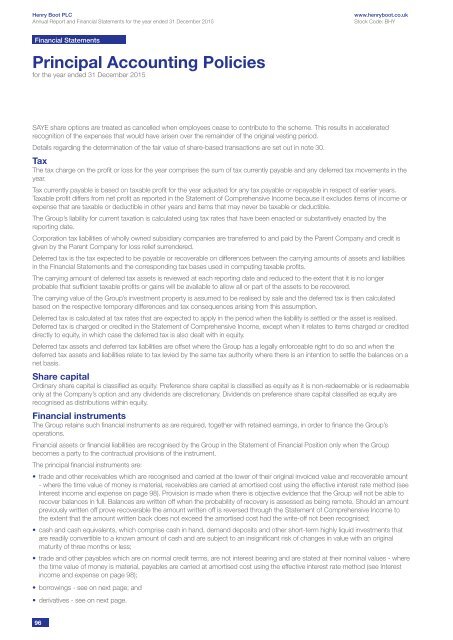Cohesive Consistent Confident
4mZ0Bv
4mZ0Bv
Create successful ePaper yourself
Turn your PDF publications into a flip-book with our unique Google optimized e-Paper software.
Henry Boot PLC<br />
Annual Report and Financial Statements for the year ended 31 December 2015<br />
www.henryboot.co.uk<br />
Stock Code: BHY<br />
Financial Statements<br />
Principal Accounting Policies<br />
for the year ended 31 December 2015<br />
SAYE share options are treated as cancelled when employees cease to contribute to the scheme. This results in accelerated<br />
recognition of the expenses that would have arisen over the remainder of the original vesting period.<br />
Details regarding the determination of the fair value of share-based transactions are set out in note 30.<br />
Tax<br />
The tax charge on the profit or loss for the year comprises the sum of tax currently payable and any deferred tax movements in the<br />
year.<br />
Tax currently payable is based on taxable profit for the year adjusted for any tax payable or repayable in respect of earlier years.<br />
Taxable profit differs from net profit as reported in the Statement of Comprehensive Income because it excludes items of income or<br />
expense that are taxable or deductible in other years and items that may never be taxable or deductible.<br />
The Group’s liability for current taxation is calculated using tax rates that have been enacted or substantively enacted by the<br />
reporting date.<br />
Corporation tax liabilities of wholly owned subsidiary companies are transferred to and paid by the Parent Company and credit is<br />
given by the Parent Company for loss relief surrendered.<br />
Deferred tax is the tax expected to be payable or recoverable on differences between the carrying amounts of assets and liabilities<br />
in the Financial Statements and the corresponding tax bases used in computing taxable profits.<br />
The carrying amount of deferred tax assets is reviewed at each reporting date and reduced to the extent that it is no longer<br />
probable that sufficient taxable profits or gains will be available to allow all or part of the assets to be recovered.<br />
The carrying value of the Group’s investment property is assumed to be realised by sale and the deferred tax is then calculated<br />
based on the respective temporary differences and tax consequences arising from this assumption.<br />
Deferred tax is calculated at tax rates that are expected to apply in the period when the liability is settled or the asset is realised.<br />
Deferred tax is charged or credited in the Statement of Comprehensive Income, except when it relates to items charged or credited<br />
directly to equity, in which case the deferred tax is also dealt with in equity.<br />
Deferred tax assets and deferred tax liabilities are offset where the Group has a legally enforceable right to do so and when the<br />
deferred tax assets and liabilities relate to tax levied by the same tax authority where there is an intention to settle the balances on a<br />
net basis.<br />
Share capital<br />
Ordinary share capital is classified as equity. Preference share capital is classified as equity as it is non-redeemable or is redeemable<br />
only at the Company’s option and any dividends are discretionary. Dividends on preference share capital classified as equity are<br />
recognised as distributions within equity.<br />
Financial instruments<br />
The Group retains such financial instruments as are required, together with retained earnings, in order to finance the Group’s<br />
operations.<br />
Financial assets or financial liabilities are recognised by the Group in the Statement of Financial Position only when the Group<br />
becomes a party to the contractual provisions of the instrument.<br />
The principal financial instruments are:<br />
• trade and other receivables which are recognised and carried at the lower of their original invoiced value and recoverable amount<br />
- where the time value of money is material, receivables are carried at amortised cost using the effective interest rate method (see<br />
Interest income and expense on page 98). Provision is made when there is objective evidence that the Group will not be able to<br />
recover balances in full. Balances are written off when the probability of recovery is assessed as being remote. Should an amount<br />
previously written off prove recoverable the amount written off is reversed through the Statement of Comprehensive Income to<br />
the extent that the amount written back does not exceed the amortised cost had the write-off not been recognised;<br />
• cash and cash equivalents, which comprise cash in hand, demand deposits and other short-term highly liquid investments that<br />
are readily convertible to a known amount of cash and are subject to an insignificant risk of changes in value with an original<br />
maturity of three months or less;<br />
• trade and other payables which are on normal credit terms, are not interest bearing and are stated at their nominal values - where<br />
the time value of money is material, payables are carried at amortised cost using the effective interest rate method (see Interest<br />
income and expense on page 98);<br />
• borrowings - see on next page; and<br />
• derivatives - see on next page.<br />
96


